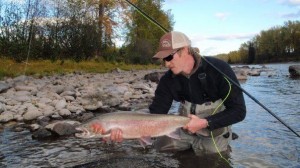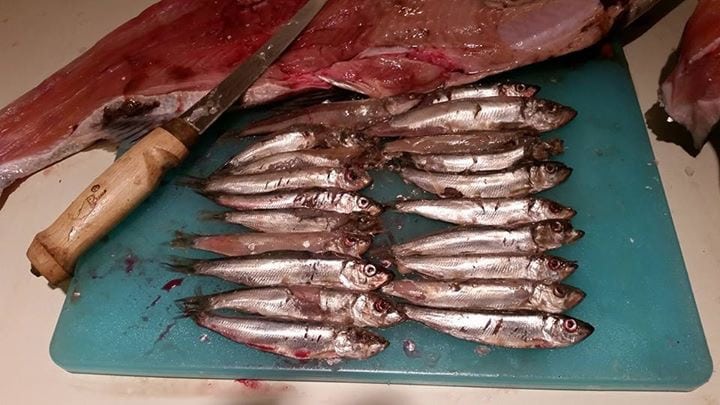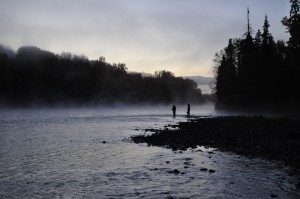Outlook
Well it has been another wet week in Vancouver. River conditions have been a challenge and the valley rivers have been blown out. The Sea to Sky rivers have been up and down but the guys who know how to watch river levels have had some good fishing.
Looking into the weekend, the valley will still have water level issues but when things have been blown out for an extended period of time the fishing will be hot when water levels drop. It is not a bad idea to start looking at your schedule to book some time off for next week or the week after.
The Squamish system came down into fish-able levels yesterday and depending on how much water comes, we may have windows of good fishing. Watch the BC water levels site closely and be flexible with your schedules. We heard more whispering of steelhead in that direction and though it is still early we can start thinking steelhead on the Squamish in the next few weeks. Check out Matt’s report for a detailed breakdown of how to swing a fly, the go to technique for bull trout and steelhead now that egg fishing is slowing.
The weather has also kept many of the boats off the water on the saltwater scene but there looks to be some decent weather in the forecast for next week and historically this is a great time to chase winter chinook. Check out Jason’s report below.
Though the Harrison is a little high for hiking the shore lines but we are excited to see it come down and cutthroat fishing should be happening when it does. Our Harrison Cutthroat course is coming up next month and if you want to tackle this unique and very rewarding fishery you will not want to miss out!
Fishing Courses
We still have spots in our March “Fly Fishing For Searun Cutthroat” courses. Call to sign up today! 604-872-2204
Fly Fishing For Searun Cutthroat Trout In Rivers
Dates 1: Seminar Mar 9th , Guided Mar 12th or 13th Date 2: Seminar Mar 29 Guided April 2nd or 3rd
This spring make sure to get out and take advantage of the world-class cutthroat fishing in the Lower Mainland. This cutthroat course is designed to educate you on the life cycle, location, seasonal feeding habits, and successful techniques and flies used to catch these elusive yet aggressive fish. This course consists of a 3hr evening seminar and a fully guided day on the water. Call to sign up today. 604-872-2204.
ON TO THE REPORT
Squamish River Fishing Report
River levels have been up and down over the last 2 weeks but when things have come in to shape we have heard of some great fishing. Bulltrout anglers have been switching over to steamer patterns and though egg fishing has still been productive we should see more and more reports of anglers having success with the swung fly technique and streamers. With this in mind I have put together a simple yet thorough write up on why we swing the fly. It is focused on steelhead but if you lighten up your presentation and tweak you flies it is one of the best methods for targeting bulltrout.
Why We Swing…Winter Steelhead Techniques
Winter Steelhead Techniques
Fishing for winter steelhead with a fly is one of the most daunting challenges of our sport. Anglers can spend years waiting for that first wondrous pull. There are a number of successful techniques but the swung fly has become the most commonly used. Let’s take a moment to look at why this simple technique is the method of choice and should be the prime focus for anglers.
Reason 1 – It is simple. It can be repeated thousands of times with little need for variation.
Reason 2 – It covers large stretches of water quickly and thoroughly.
Reason 3 – The act of swinging a fly perfectly imitates wild prey species. Immature salmon, small trout, ditch eels and leaches will instinctively turn up stream and fight against the current as they move to the safety of shallow water. Watch the salmon fry in your local river. The swing is a perfect imitation of this behavior and one of the most effective predatory triggers.
Reason 4 – With a swing, the angler maintains direct contact with the fly. Recognizing a take is simple when the rod tries to jump from your hand. This immediate feedback will help you gain the experience needed to become a successful steelheader.
Some will argue that techniques like nymphing and indicator egg fishing are more productive but understanding how to mend through a run, recognizing the strike and then reacting to it after hours with no action, takes skill and experience. Using an egg, I have watched novice and experienced anglers alike miss strikes without realizing that a fish has taken their presentation. The river only knows how many times I have been fooled.
Keys to Fishing the Swung Fly
Water Speed:
Find runs that have walking pace current in depths from 4 to 6 feet. This is perfect steelhead holding water but more importantly, it is water where they are most likely to see a natural salmon fry, leach or ditch eel making a move across the river.
Structure:
Look to the shore. The rocks on the shore are a good indication of what lies beneath the water. If head size boulders litter the shore, it is a good place to start. Ideal steelhead holding water contains head size rocks with the odd suitcase size boulder breaking up the flow. Try to avoid sand bottoms.
The Swing:
Now that we have found ideal water, let’s look at the simple mechanics of the swing.
The angler casts somewhere between 90 degrees cross steam to 45 degrees down stream. Between the 90 and 45 degree mark, the angler should make an aggressive mend up stream. This dead drifts the fly, allowing it to sink. At 45 degrees, the fly begins to swing.
Use your trigger finger to maintain direct contact with the line. Follow the swing with your rod pointing to the fly. Hold the tip a foot off the water and try to keep subsequent mends and rod movement to a minimum.
When the line straightens out down stream, let the fly dangle for a good 5 seconds. Once again, this imitates natural prey behavior. Your fly has just made a harrowing escape from the heavy water and is settling in slower, safer holding water. You will be surprised how many fish take during this dangle.
After five full seconds, begin stripping. Make the first two or three pulls with a tentative movement. The odd fish will hit as the fly begins to pull away.
Covering Water:
With the fly retrieved, take 1 to 4 steps down stream (2 – 6 ft) and repeat the process. This act of moving through a run is just as important as the cast and swing. All experienced steelheaders understand that the more water they cover, the better their chances. For a more detailed explanation of how to move through a run, look for the article: “Understanding the Steelhead Shuffle” in our next news letter.
Depth Control:
For winter steelhead in water temperatures of 49 degrees and below, the key is to keep the fly as close to the bottom as possible. With modern fly equipment, we have a variety of tools to help us achieve this goal. Within your arsenal, you should have type 3, 6 and 8 sink tips. I recommend the 15 ft length. I find that the type 6 is most commonly on the end of my line and is usually a good place to start. It is also an idea to take advantage of T series sink tips, Rio’s most aggressive sink tip material. Have two “heads” of T14 and T11 in ten foot lengths is what I use most of the time when spey fishing and the type 6 sink-tip is what I use most of the time when single hand fly fishing.
When first learning a run, try to go as deep as comfortably possible. Once you begin to snag, lighten your presentation. To gauge this depth, I start casting at 45 degrees and then work the subsequent casts more up stream. If I touch bottom I cast 5 degrees father down stream and fish that angle until I feel as though the depth has changed and that I need to “find” the bottom again. Depth is important but if you can’t find the bottom it is not the end of the world. I would much rather an angler fish a little bit shallow rather than fight through snags and break up his rhythm every few casts.
When that first spine tingling tug comes, stay calm and don’t set the hook. Let the steelhead take and turn on the fly. Slowly raise your rod. With the rod 45 degrees off the water and the fish still showing good solid tension, make a short firm hook set and let the fun begin.
Recommended Gear
Rods: Single hand: 7 – 9 weight in the 8 to 10 foot range & Spey Rods: 7-9 wt 10-15ft
Lines: Shooting heads and sink tip lines 7-9
Reels: Something that can handle at least 150 ft of backing. Staff Favorites: Nautilus, Redington, 3Tand, Sage, Redington & Abel
Leader: 3.5 – 5ft of 8-15 lb. Staff Favorites: Maxima, Maxima, and more Maxima
If you have any steelhead questions please do not hesitate to drop by Pacific Angler or contact me or one of the friendly staff at the store at 604-872-2204.
Tight Lines,
Matt Sharp
Chilliwack River Fishing Report
The Chilliwack will be on the high side through the weekend and possibly blown out if the predicted rainfall occurs. It may become fishable mid next week. Once the river comes down the fish will be rested and very willing biters. Other than watching the graph drop there isn’t much to report. The river can be very dangerous at any height but it is extremely dangerous now that the river is running extremely high. If you decide to venture out to the river be very cautions.
Chehalis River Fishing Report
The Chehalis may be an option but it is tough to say as there is no graph and we haven’t heard of many reports. This river is also known for rising quickly so be careful when walking it’s banks in the rain. Larger and brighter presentations for reduced clarity i.e. 6” Fluorescent Pink Worms and smaller softer patterns for clear water i.e. Single Jensen Egg and White Wool.
Vancouver Salmon Fishing Report February 18th, 2016
Well to say it has been wet lately has been an understatement. For the most part we have been on the sidelines with the wet and windy weather. There was one exception this past week and that was Tuesday. Those that were lucky enough to get out on Tuesday had some good fishing, calm seas, and sunny skies. Except for that day though, the weather has been pretty ugly.
It looks like this weekend will be a mix of sun and clouds and by Monday we are forecast to get a few days of back to back sun! The winds don’t look that bad either, so I am sure we will be out a lot more this coming week.
The reports from Vancouver Harbour have not been that good. The seals have been very frustrating. They are following you around at the Cap Mouth and the Freighters as well. A friend of ours was out the other day and every fish he hooked was taken by a seal! If you do have a seal following you make sure to pick up your gear and move. If you do hook a good fish it will definitely be taken by the seal so you might as well move spots. If you can get away from the seals, there are few nice fish around this time of year. That can be easier said than done.
Okay, so that was a little depressing, so let’s talk about some of the good news. There has been some nice fish taken up Howe Sound. We are starting to see some of the bigger white springs being taken now and there have been some fish in the mid to high teens. Spoons have been working well, but so has bait! The fish have had a lot of small bait in their stomachs and anchovies have been working well. They are about the size of the bait we have been seeing.

A customer shared this picture with us! Look at all the herring that where inside this winter chinook!!
As usual, you want to keep your gear close to the bottom as this is where the bait is. Some flashers with some glow on them like a Green Onion Glow or Chartreuse Glow are always good producers. For spoons try the smaller sizes like a Pesca in 2.5 or 3.5 and a Kingfisher in 3.0 or 3.5. These smaller sizes will represent the size of bait this time of year. We are often fishing in 150-250 feet of water, and close to the bottom, so make sure your spoon has some glow on it. Popular colours that have glow are Gut Bomb, Leprechaun, Sucker Punch, Irish Cream, and Yellow Tail. Another good tip is to use some scent. Put some gel scent on your spoons. Productive choices are herring, anchovy, and bloody tuna or bloody tuna with anise. We always put scent on our spoons. It really does make a difference, especially for chinook.
If you would like to get out on the water and enjoy the sun and some tasty winter chinook this week, give us a call at 778-788-8582.
Or for any questions on the report call Pacific Angler at 604-872-2204.
See you in the shop or on the water,







